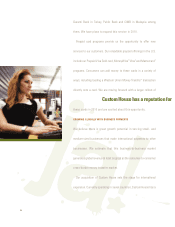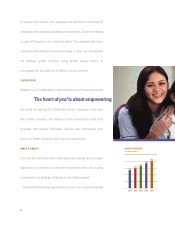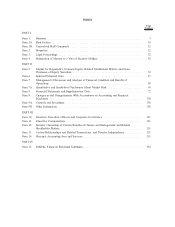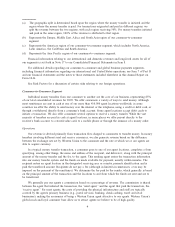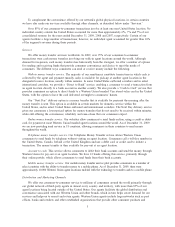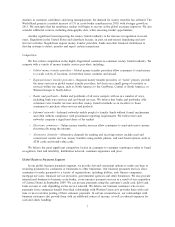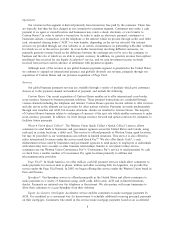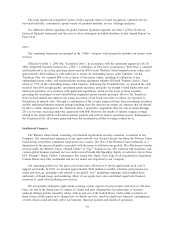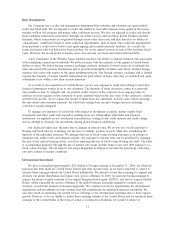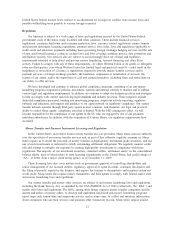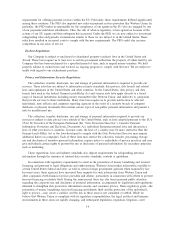Western Union 2009 Annual Report Download - page 18
Download and view the complete annual report
Please find page 18 of the 2009 Western Union annual report below. You can navigate through the pages in the report by either clicking on the pages listed below, or by using the keyword search tool below to find specific information within the annual report.
(a) The geographic split is determined based upon the region where the money transfer is initiated and the
region where the money transfer is paid. For transactions originated and paid in different regions, we
split the revenue between the two regions, with each region receiving 50%. For money transfers initiated
and paid in the same region, 100% of the revenue is attributed to that region.
(b) Represents the Europe, Middle East, Africa and South Asia region of our consumer-to-consumer
segment.
(c) Represents the Americas region of our consumer-to-consumer segment, which includes North America,
Latin America, the Caribbean and South America.
(d) Represents the Asia Pacific region of our consumer-to-consumer segment.
Financial information relating to our international and domestic revenues and long-lived assets for all of
our segments is set forth in Note 17 to our Consolidated Financial Statements in Item 8.
For additional details regarding our consumer-to-consumer and global business payments segments,
including financial information regarding our international and United States operations, see Item 7 of Part II
and our financial statements and the notes to those statements included elsewhere in this Annual Report on
Form 10-K.
See Risk Factors for a discussion of certain risks relating to our foreign operations.
Consumer-to-Consumer Segment
Individual money transfers from one consumer to another are the core of our business, representing 85%
of our total consolidated revenues for 2009. We offer consumers a variety of ways to send money. Although
most remittances are sent in cash at one of our more than 410,000 agent locations worldwide, in some
countries we offer the ability to send money over the internet or the telephone, using a credit or debit card, or
through a withdrawal directly from a consumer’s bank account. Some agent locations accept debit cards to
initiate a transaction. We also offer consumers several options to receive a money transfer. While the vast
majority of transfers are paid in cash at agent locations, in some places we offer payout directly to the
receiver’s bank account, to a stored-value card, to a mobile phone or through the issuance of a money order.
Operations
Our revenue is derived primarily from transaction fees charged to consumers to transfer money. In money
transfers involving different send and receive currencies, we also generate revenue based on the difference
between the exchange rate set by Western Union to the consumer and the rate at which we or our agents are
able to acquire currency.
In a typical money transfer transaction, a consumer goes to one of our agent locations, completes a form
specifying, among other things, the name and address of the recipient, and delivers it, along with the principal
amount of the money transfer and the fee, to the agent. This sending agent enters the transaction information
into our money transfer system and the funds are made available for payment, usually within minutes. The
recipient enters an agent location in the designated receiving area or country, presents identification and is
paid the transferred amount. Recipients do not pay a fee (although in limited circumstances, a tax may be
imposed on the payment of the remittance). We determine the fee paid by the sender, which generally is based
on the principal amount of the transaction and the locations to and from which the funds are sent and are to
be transferred.
We generally pay our agents a commission based on a percentage of revenue. The commission is shared
between the agent that initiated the transaction, the “send agent,” and the agent that paid the transaction, the
“receive agent.” For most agents, the costs of providing the physical infrastructure and staff are typically
covered by the agent’s primary business (e.g., postal services, banking, check cashing, travel and retail
businesses), making the economics of being a Western Union agent attractive to our agents. Western Union’s
global reach and loyal consumer base allow us to attract agents we believe to be of high quality.
4


